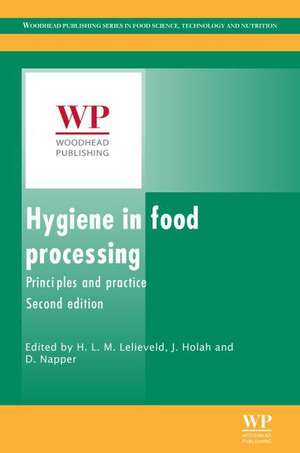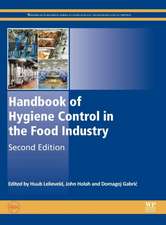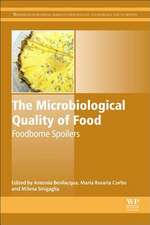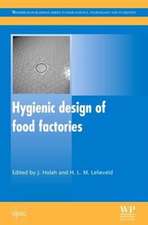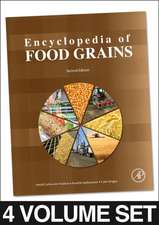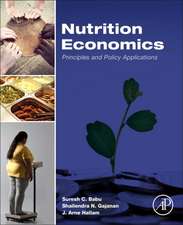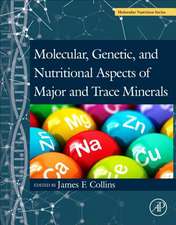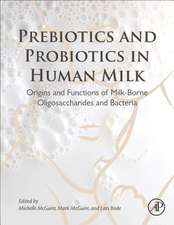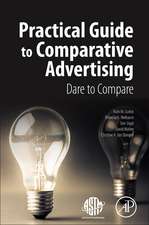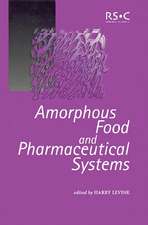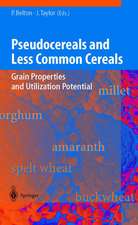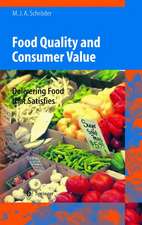Hygiene in Food Processing: Principles and Practice: Woodhead Publishing Series in Food Science, Technology and Nutrition
Editat de H.L.M. Lelieveld, John Holah, David Napperen Limba Engleză Hardback – 12 dec 2013
Part one addresses microbial risks in foods and the corresponding regulation in the European Union. Part two discusses the hygienic design of food factory infrastructure, encompassing the design and materials for the factory itself, as well as food processing equipment. This edition includes a new chapter on the control of compressed gases used to pneumatically operate equipment. Part three focuses on cleaning and disinfection practices in food processing. The chapter on cleaning in place also considers more cost-effective systems, and complements the additional chapter on maintenance of equipment. These chapters also explore issues such as the hygiene of workers, potential infection by foreign bodies, and pest control. Further, the chapter on microbiological sampling explains how to calculate the risk of contamination depending on the product's environment.
This essential second edition is useful to professionals responsible for hygiene in the food industry. It provides a comprehensive, yet concise and practical reference source for food plant managers, suppliers of food processing equipment, building contractors, and food inspectors looking for an authoritative introduction to hygiene regulation, hygienic design, and sanitation.
- Provides a revised overview of the practices for safe processing
- Incorporates additional chapters concerning pest control, microbiological environmental sampling, and the economics of food plants
- This essential second edition is useful for professionals responsible for hygiene in the food industry
Din seria Woodhead Publishing Series in Food Science, Technology and Nutrition
- 15%
 Preț: 391.19 lei
Preț: 391.19 lei - 24%
 Preț: 1210.03 lei
Preț: 1210.03 lei - 24%
 Preț: 946.43 lei
Preț: 946.43 lei - 24%
 Preț: 960.56 lei
Preț: 960.56 lei - 23%
 Preț: 1419.50 lei
Preț: 1419.50 lei - 9%
 Preț: 1205.99 lei
Preț: 1205.99 lei - 24%
 Preț: 1189.10 lei
Preț: 1189.10 lei - 9%
 Preț: 1006.66 lei
Preț: 1006.66 lei - 9%
 Preț: 984.09 lei
Preț: 984.09 lei - 9%
 Preț: 1206.85 lei
Preț: 1206.85 lei - 24%
 Preț: 1081.43 lei
Preț: 1081.43 lei - 24%
 Preț: 1185.22 lei
Preț: 1185.22 lei - 9%
 Preț: 922.07 lei
Preț: 922.07 lei - 24%
 Preț: 1192.22 lei
Preț: 1192.22 lei - 9%
 Preț: 1215.75 lei
Preț: 1215.75 lei - 24%
 Preț: 1162.37 lei
Preț: 1162.37 lei - 9%
 Preț: 950.09 lei
Preț: 950.09 lei - 24%
 Preț: 1162.62 lei
Preț: 1162.62 lei - 24%
 Preț: 801.31 lei
Preț: 801.31 lei - 27%
 Preț: 379.84 lei
Preț: 379.84 lei - 29%
 Preț: 1336.07 lei
Preț: 1336.07 lei - 24%
 Preț: 798.74 lei
Preț: 798.74 lei - 24%
 Preț: 1333.02 lei
Preț: 1333.02 lei - 9%
 Preț: 1018.93 lei
Preț: 1018.93 lei - 31%
 Preț: 922.77 lei
Preț: 922.77 lei - 9%
 Preț: 1045.58 lei
Preț: 1045.58 lei - 24%
 Preț: 1131.77 lei
Preț: 1131.77 lei - 23%
 Preț: 1635.83 lei
Preț: 1635.83 lei - 9%
 Preț: 1277.62 lei
Preț: 1277.62 lei - 24%
 Preț: 1049.04 lei
Preț: 1049.04 lei - 24%
 Preț: 1134.60 lei
Preț: 1134.60 lei - 9%
 Preț: 1076.36 lei
Preț: 1076.36 lei - 24%
 Preț: 1158.21 lei
Preț: 1158.21 lei - 9%
 Preț: 1065.06 lei
Preț: 1065.06 lei - 9%
 Preț: 1067.39 lei
Preț: 1067.39 lei - 24%
 Preț: 812.03 lei
Preț: 812.03 lei - 9%
 Preț: 1203.13 lei
Preț: 1203.13 lei - 23%
 Preț: 1237.19 lei
Preț: 1237.19 lei - 24%
 Preț: 948.79 lei
Preț: 948.79 lei - 23%
 Preț: 1138.06 lei
Preț: 1138.06 lei - 9%
 Preț: 868.43 lei
Preț: 868.43 lei - 24%
 Preț: 871.98 lei
Preț: 871.98 lei - 20%
 Preț: 1272.59 lei
Preț: 1272.59 lei - 9%
 Preț: 1002.45 lei
Preț: 1002.45 lei - 9%
 Preț: 505.72 lei
Preț: 505.72 lei - 9%
 Preț: 1062.13 lei
Preț: 1062.13 lei - 24%
 Preț: 1306.94 lei
Preț: 1306.94 lei
Preț: 1195.06 lei
Preț vechi: 1673.09 lei
-29% Nou
Puncte Express: 1793
Preț estimativ în valută:
228.67€ • 239.39$ • 189.21£
228.67€ • 239.39$ • 189.21£
Carte tipărită la comandă
Livrare economică 29 martie-12 aprilie
Preluare comenzi: 021 569.72.76
Specificații
ISBN-13: 9780857094292
ISBN-10: 0857094297
Pagini: 640
Ilustrații: illustrations
Dimensiuni: 156 x 234 x 43 mm
Greutate: 1.04 kg
Ediția:2. Auflage.
Editura: ELSEVIER SCIENCE
Seria Woodhead Publishing Series in Food Science, Technology and Nutrition
ISBN-10: 0857094297
Pagini: 640
Ilustrații: illustrations
Dimensiuni: 156 x 234 x 43 mm
Greutate: 1.04 kg
Ediția:2. Auflage.
Editura: ELSEVIER SCIENCE
Seria Woodhead Publishing Series in Food Science, Technology and Nutrition
Cuprins
- Contributor contact details
- Woodhead Publishing Series in Food Science, Technology and Nutrition
- Introduction
- Part I: Microbial food safety risks and hygiene regulation
- 1: Food hygiene regulation in the European Union (EU)
- Abstract
- 1.1 Introduction
- 1.2 History of hygiene regulation in the European Union (EU)
- 1.3 Key elements of hygiene regulation in the EU
- 1.4 Content of the hygiene regulations
- 1.5 Hazard analysis critical control point (HACCP)
- 1.6 European hygiene legislation with regard to equipment
- 1.7 Hygiene regulations in relation to private food safety standards
- 1.8 Conclusion
- 1.9 Sources of further information and advice
- 2: Hazards, sources and vectors of contamination
- Abstract
- 2.1 Introduction
- 2.2 Physical contaminants
- 2.3 Chemical contaminants
- 2.4 Microbiological contamination
- 2.5 Hazard sources
- 2.6 Hazard vectors and controls
- 2.7 Recommended procedure for developing a processing environment plan (PEP)
- 2.8 Conclusion
- 1: Food hygiene regulation in the European Union (EU)
- Part II: Hygienic design of food factory infrastructure
- 3: Hygienic factory design for food processing
- Abstract
- 3.1 Introduction
- 3.2 Design, construction and maintenance of the site
- 3.3 Building structure
- 3.4 High-care/risk areas
- 3.5 Storage areas
- 3.6 Personnel areas
- 3.7 Cleaning facilities: food, equipment and chemicals
- 3.8 Roofs
- 3.9 Floors
- 3.10 Drainage
- 3.11 Walls
- 3.12 Doors
- 3.13 Windows
- 3.14 Ceilings
- 3.15 Ventilation and temperature control
- 3.16 Lighting
- 3.17 Services
- 3.18 Water
- 3.19 Food and solid waste
- 3.20 Conclusion
- 4: Hygienic design of food processing equipment
- Abstract
- 4.1 Introduction: key criteria in hygienic design
- 4.2 Risk assessment in equipment design
- 4.3 Regulatory requirements for hygienic equipment design: the European Union (EU)
- 4.4 Drainability
- 4.5 Materials of construction
- 4.6 Surface finish
- 4.7 Corners, crevices and dead spaces
- 4.8 Welds and joints
- 4.9 Fasteners
- 4.10 Seals
- 4.11 Shaft ends
- 4.12 Doors, covers and panels
- 4.13 Rims
- 4.14 Conveyor belts
- 4.15 Equipment controls and instrumentation
- 4.16 Equipment installation
- 4.17 Insulation and cladding
- 4.18 Conclusion
- 5: Food processing equipment construction materials
- Abstract
- 5.1 Introduction
- 5.2 Metals in food processing equipment
- 5.3 Plastics, composites and elastomers
- 5.4 Other materials
- 6: Verification and certification of hygienic design in food processing
- Abstract
- 6.1 Introduction
- 6.2 Testing methods
- 6.3 Particular tests for cleanability
- 6.4 Future trends
- 6.5 Certification of equipment
- 6.6 Conclusion
- 7: Control of airborne contamination in food processing
- Abstract
- 7.1 Introduction: why control of airborne contamination is important in food production
- 7.2 Sources of airborne contamination
- 7.3 Dust control
- 7.4 Control of environmental air quality
- 7.5 Process air control
- 7.6 Air disinfection systems
- 7.7 Air sampling
- 7.8 Guide to maximum airborne counts for different product contamination rates
- 7.9 Conclusion and future trends
- 7.10 Sources of further information and advice
- 8: Hygiene control in the application of compressed air and food gases
- Abstract
- 8.1 Introduction
- 8.2 Hygiene control in the supply and application of food safe compressed air
- 8.3 Compressed air systems: components and location
- 8.4 Equipment to remove the bulk of water
- 8.5 Filtration and drying in compressed air systems
- 8.6 Design and installation of compressed air distribution system
- 8.7 Measures and procedures to prevent compressed air from contaminating the food processing area
- 8.8 Monitoring and maintenance of compressed air systems
- 8.9 Hygiene control in the supply and application of food gases
- 8.10 Conclusion
- 3: Hygienic factory design for food processing
- Part III: Hygiene practices in food processing
- 9: Cleaning and disinfection practices in food processing
- Abstract
- 9.1 Introduction
- 9.2 Sanitation principles
- 9.3 Cleaning chemicals
- 9.4 Disinfectants
- 9.5 Testing disinfectants
- 9.6 Water quality
- 9.7 Sanitation methodology
- 9.8 Wholeroom disinfection
- 9.9 Sanitation procedures
- 9.10 Evaluation of sanitation effectiveness
- 9.11 Sanitation management
- 9.12 Conclusion
- 10: Cleaning in place (CIP) in food processing
- Abstract
- 10.1 Introduction
- 10.2 Cleaning chemicals and disinfectants for cleaning in place (CIP)
- 10.3 Other key factors for an effective CIP process
- 10.4 The main types of CIP systems
- 10.5 Centralized/decentralized CIP systems
- 10.6 Design of CIP line circuit
- 10.7 Cleaning of process vessels, large-volume equipment and tanks
- 10.8 Spray and jet devices for CIP
- 10.9 Installation, positioning and operation of tank cleaning devices
- 10.10 Managing tank cleaning
- 10.11 Automation
- 10.12 Automated self-cleaning of CIP systems
- 10.13 Future trends
- 10.14 Acknowledgement
- 11: Hygienic practices for equipment maintenance
- Abstract
- 11.1 Introduction
- 11.2 Scheduled maintenance
- 11.3 Design, installation and working practices for improved hygiene during maintenance and repairs
- 11.4 Purchase and acceptance of bought-in equipment, tools and lubricants
- 11.5 Maintenance, repair and lubrication according to the principles of hygienic design
- 11.6 Personal hygiene practices during maintenance operations in the food industry
- 11.7 Hygienic maintenance and repair practices in the food industry
- 11.8 Evaluation of the quality of maintenance work done and record keeping
- 11.9 Conclusion
- 12: Personal hygiene in the food industry
- Abstract
- 12.1 Introduction: definition of personal hygiene
- 12.2 People as sources of contamination
- 12.3 Management practices for controlling contamination
- 12.4 Personal hygiene policy and practices for controlling contamination
- 12.5 Control of indirect contamination from people
- 12.6 Conclusion
- 13: Food hygiene and foreign bodies
- Abstract
- 13.1 Introduction
- 13.2 The range of foreign bodies
- 13.3 The role of good hygiene practice in managing these hazards
- 13.4 Methods of preventing foreign body contamination
- 13.5 Detection and removal systems for foreign bodies
- 13.6 Conclusion
- 13.7 Future trends
- 13.8 Sources of further information and advice
- 14: Pest control in food businesses: an introduction
- Abstract
- 14.1 Introduction
- 14.2 Integrated pest management (IPM)
- 14.3 Pest control programs
- 14.4 Contents of a pest control program
- 14.5 Data collection
- 14.6 Communication
- 14.7 Maintaining and evaluating the pest control program
- 14.8 Conclusion
- 14.9 Future trends
- 15: Pest control of stored food products: insects and mites
- Abstract
- 15.1 Introduction
- 15.2 The spread of pests
- 15.3 Physical control of pests
- 15.4 Chemical control of pests
- 15.5 Biological control of pests
- 15.6 Threats to successful control
- 15.7 Conclusion
- 16: Microbiological environmental sampling, records and record interpretation
- Abstract
- 16.1 Introduction
- 16.2 Sampling programmes and strategies
- 16.3 Sampling methods: monitoring surfaces
- 16.4 Sampling methods: validation and verification of surfaces
- 16.5 Sampling of personnel
- 16.6 Air and water sampling
- 16.7 Practical sampling
- 16.8 Sample transport and processing
- 16.9 Conclusion
- 17: Economics and management of hygiene in food plants
- Abstract
- 17.1 Introduction: the perception of cleaning costs as an example of the perception of hygiene
- 17.2 The real cost of hygiene
- 17.3 Direct factors
- 17.4 Indirect factors
- 17.5 Overview of optimisation tools
- 17.6 Conclusion and future trends
- 9: Cleaning and disinfection practices in food processing
- Index
